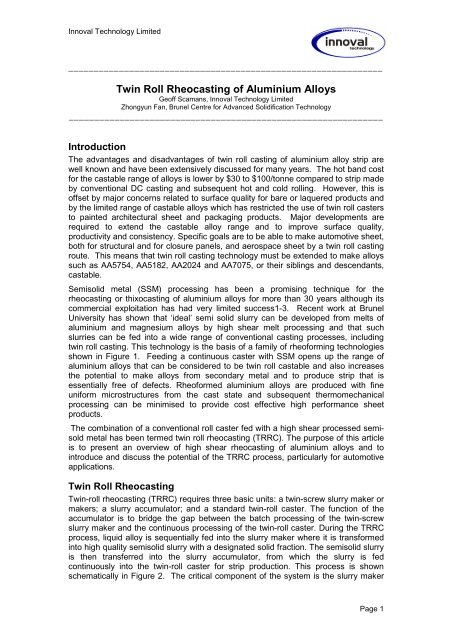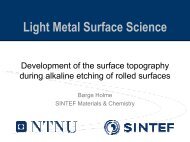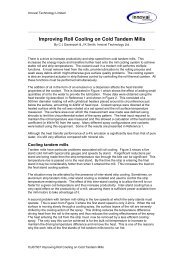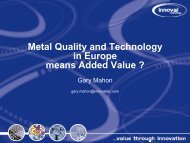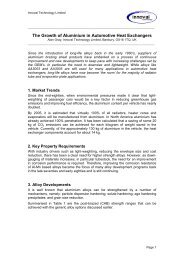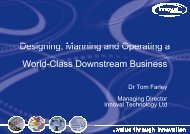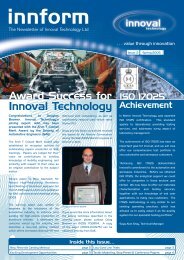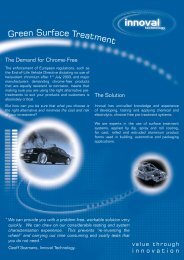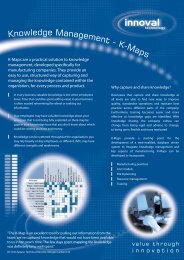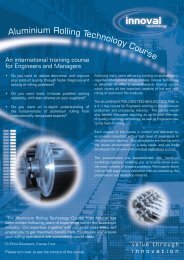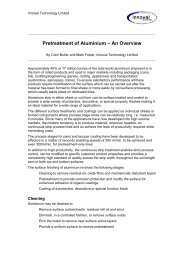Twin Roll Rheocasting of Aluminium Alloys - Innoval Technology Ltd
Twin Roll Rheocasting of Aluminium Alloys - Innoval Technology Ltd
Twin Roll Rheocasting of Aluminium Alloys - Innoval Technology Ltd
Create successful ePaper yourself
Turn your PDF publications into a flip-book with our unique Google optimized e-Paper software.
<strong>Innoval</strong> <strong>Technology</strong> Limited<br />
______________________________________________________________<br />
<strong>Twin</strong> <strong>Roll</strong> <strong>Rheocasting</strong> <strong>of</strong> <strong>Aluminium</strong> <strong>Alloys</strong><br />
Ge<strong>of</strong>f Scamans, <strong>Innoval</strong> <strong>Technology</strong> Limited<br />
Zhongyun Fan, Brunel Centre for Advanced Solidification <strong>Technology</strong><br />
______________________________________________________________<br />
Introduction<br />
The advantages and disadvantages <strong>of</strong> twin roll casting <strong>of</strong> aluminium alloy strip are<br />
well known and have been extensively discussed for many years. The hot band cost<br />
for the castable range <strong>of</strong> alloys is lower by $30 to $100/tonne compared to strip made<br />
by conventional DC casting and subsequent hot and cold rolling. However, this is<br />
<strong>of</strong>fset by major concerns related to surface quality for bare or laquered products and<br />
by the limited range <strong>of</strong> castable alloys which has restricted the use <strong>of</strong> twin roll casters<br />
to painted architectural sheet and packaging products. Major developments are<br />
required to extend the castable alloy range and to improve surface quality,<br />
productivity and consistency. Specific goals are to be able to make automotive sheet,<br />
both for structural and for closure panels, and aerospace sheet by a twin roll casting<br />
route. This means that twin roll casting technology must be extended to make alloys<br />
such as AA5754, AA5182, AA2024 and AA7075, or their siblings and descendants,<br />
castable.<br />
Semisolid metal (SSM) processing has been a promising technique for the<br />
rheocasting or thixocasting <strong>of</strong> aluminium alloys for more than 30 years although its<br />
commercial exploitation has had very limited success1-3. Recent work at Brunel<br />
University has shown that ‘ideal’ semi solid slurry can be developed from melts <strong>of</strong><br />
aluminium and magnesium alloys by high shear melt processing and that such<br />
slurries can be fed into a wide range <strong>of</strong> conventional casting processes, including<br />
twin roll casting. This technology is the basis <strong>of</strong> a family <strong>of</strong> rhe<strong>of</strong>orming technologies<br />
shown in Figure 1. Feeding a continuous caster with SSM opens up the range <strong>of</strong><br />
aluminium alloys that can be considered to be twin roll castable and also increases<br />
the potential to make alloys from secondary metal and to produce strip that is<br />
essentially free <strong>of</strong> defects. Rhe<strong>of</strong>ormed aluminium alloys are produced with fine<br />
uniform microstructures from the cast state and subsequent thermomechanical<br />
processing can be minimised to provide cost effective high performance sheet<br />
products.<br />
The combination <strong>of</strong> a conventional roll caster fed with a high shear processed semisold<br />
metal has been termed twin roll rheocasting (TRRC). The purpose <strong>of</strong> this article<br />
is to present an overview <strong>of</strong> high shear rheocasting <strong>of</strong> aluminium alloys and to<br />
introduce and discuss the potential <strong>of</strong> the TRRC process, particularly for automotive<br />
applications.<br />
<strong>Twin</strong> <strong>Roll</strong> <strong>Rheocasting</strong><br />
<strong>Twin</strong>-roll rheocasting (TRRC) requires three basic units: a twin-screw slurry maker or<br />
makers; a slurry accumulator; and a standard twin-roll caster. The function <strong>of</strong> the<br />
accumulator is to bridge the gap between the batch processing <strong>of</strong> the twin-screw<br />
slurry maker and the continuous processing <strong>of</strong> the twin-roll caster. During the TRRC<br />
process, liquid alloy is sequentially fed into the slurry maker where it is transformed<br />
into high quality semisolid slurry with a designated solid fraction. The semisolid slurry<br />
is then transferred into the slurry accumulator, from which the slurry is fed<br />
continuously into the twin-roll caster for strip production. This process is shown<br />
schematically in Figure 2. The critical component <strong>of</strong> the system is the slurry maker<br />
Page 1
<strong>Innoval</strong> <strong>Technology</strong> Limited<br />
that provides the conditioned semi-solid melt to be fed to the caster via the<br />
accumulator. The appropriately conditioned slurry is produced by high shear melt<br />
processing using the twin screw mechanism to apply forced convection to the<br />
solidifying liquid.<br />
High Shear Melt Processing<br />
Subjecting a melt to high shear processing means that, unlike conventional<br />
solidification under static conditions, nucleation and crystal growth occurs in a<br />
controlled dynamic environment. Research on nucleation and growth under forced<br />
convection has been very limited4 and there is only a basic understanding <strong>of</strong> the<br />
effects on nucleation rate and growth morphology. The conventional belief is that<br />
under forced convection dendrites fragment and detached dendrite arms then<br />
undergo a coarsening process to provide the observed globular particles. However,<br />
more recently it has been shown that under intensive forced convection the globular<br />
structure is more likely to be the result <strong>of</strong> spherical growth under forced convection,<br />
rather than as a consequence <strong>of</strong> dendrite arm detachment2. The globular structure<br />
is a direct result <strong>of</strong> spherical growth under intensive forced convection and the growth<br />
morphology changes from dendritic to spherical through rosette with increasing shear<br />
rate and degree <strong>of</strong> turbulence, as is shown in Figure 3. Practically, appropriate forced<br />
convection conditions <strong>of</strong> high shear rate and high intensity <strong>of</strong> turbulence are achieved<br />
within a twin screw slurry maker and typical times to produce conditioned semi-solid<br />
slurry are <strong>of</strong> the order <strong>of</strong> 10 to 20 seconds. The output from the slurry maker can be<br />
tuned to the casting volume requirement by either increasing the size <strong>of</strong> the twin<br />
screw slurry maker or by having multiple units.<br />
The <strong>Twin</strong> Screw Slurry Maker<br />
The twin-screw slurry maker has a pair <strong>of</strong> screws rotating inside a barrel. The fully<br />
intermeshing screws have specially designed pr<strong>of</strong>iles to achieve co-rotation and selfwiping.<br />
During the slurry making process, there is an extreme, ever-changing<br />
interfacial area between the solidifying alloy and the slurry maker, providing<br />
enhanced heat transfer.<br />
The complex fluid flow inside the slurry maker is characterised by high shear rate,<br />
high intensity <strong>of</strong> turbulence, and a cyclic variation <strong>of</strong> shear rate. The shear rate in the<br />
twin-screw slurry maker is continuously changing and an elemental volume <strong>of</strong> alloy<br />
melt will experience a cyclic variation <strong>of</strong> shear rate, with the shear rate being highest<br />
at the intermeshing region, and lowest between the screw root and the inner barrel<br />
surface. This is shown schematically in Figure 4. The degree <strong>of</strong> turbulence is even<br />
more difficult to quantify. However, both shear rate and degree <strong>of</strong> turbulence are<br />
proportional to the screw rotation speed. The higher the screw rotation speed, the<br />
higher the shear rate and the degree <strong>of</strong> turbulence although flow is turbulent even at<br />
low screw rotation speed.<br />
In operation, a predetermined charge <strong>of</strong> liquid alloy from the melting furnace is fed<br />
into the twin screw slurry maker. The liquid alloy is continuously cooled to the SSM<br />
processing temperature whilst being mechanically sheared, converting the liquid into<br />
semisolid slurry. The solid fraction <strong>of</strong> the semisolid slurry is controlled by the barrel<br />
temperature. Both melt temperature and composition fields inside the slurry maker<br />
are extremely uniform during this primary solidification, owing to the dispersive<br />
mixing <strong>of</strong> the twin-screw mechanism. Heterogeneous nucleation occurs continuously<br />
throughout the entire volume <strong>of</strong> the melt and all nuclei can survive and contribute to<br />
the final microstructure, and this critical process is called effective continuous<br />
nucleation. The experimentally determined volume fraction <strong>of</strong> primary particles<br />
formed in the twin-screw slurry maker as a function <strong>of</strong> shearing time and screw<br />
Page 2
<strong>Innoval</strong> <strong>Technology</strong> Limited<br />
rotation speed is shown in Figure 5. The average size <strong>of</strong> the primary particles<br />
formed in the twin-screw slurry maker as a function <strong>of</strong> shearing time and screw<br />
rotation speed is shown in Figure 6. The nuclei grow spherically with a very fast<br />
growth rate under intensive forced convection, and particle coarsening occurs<br />
through Ostwald ripening by consumption <strong>of</strong> the smaller particles. The coarsening<br />
rate is extremely slow due to the spherical particle morphology and the narrow<br />
particle size distribution. Increasing the intensity <strong>of</strong> forced convection decreases<br />
both volume fraction and particle size, but does not enhance the nucleation rate. A<br />
more detailed description <strong>of</strong> this solidification process has recently been published4.<br />
A major challenge was to find a suitable material for the construction <strong>of</strong> the screws<br />
and the barrel that would survive exposure to highly reactive aluminium melts. Initial<br />
efforts to find non-reactive materials or to use coatings were unsuccessful until the<br />
concept was changed to source a material that would react to provide a protective<br />
layer. Having found and extensively tested this material, the twin screw slurry maker<br />
can now be readily fabricated and can survive prolonged exposure to turbulent<br />
aluminium alloy melts. The twin screw slurry maker is now in its fourth design<br />
generation.<br />
Since slurry making is essentially a batch process the second key component in the<br />
slurry delivery system is the accumulator which acts as a reservoir to provide a<br />
sufficient volume <strong>of</strong> slurry for feeding into the casting system. A blade type stirrer is<br />
fitted in the accumulator to prevent particle agglomeration and to maintain the slurry<br />
uniformity. The semisolid slurry is then transferred to feed the twin roll caster.<br />
It should be realised that solidification takes place in two distinct stages; primary<br />
solidification inside the twin-screw slurry maker followed by secondary solidification<br />
<strong>of</strong> the remaining liquid in the bite <strong>of</strong> the twin roll caster.<br />
High Shear Rheo-casting <strong>of</strong> <strong>Aluminium</strong> <strong>Alloys</strong><br />
Preliminary studies have been carried out by casting high shear processed slurries <strong>of</strong><br />
aluminium alloys into a high pressure diecaster. The mechanical properties <strong>of</strong><br />
aluminium alloy A357 after rheo-diecasting are compared to those <strong>of</strong> the same alloy<br />
after thixocasting and ‘new rheocasting’ in Figure 7. The rheo-diecast A357 shows<br />
both improved strength and elongation compared to the samples produced by the<br />
other SSM casting technologies. Figure 8 shows the as rheo-diecast microstructures<br />
<strong>of</strong> AA2014 and AA7075 aerospace alloys. In both cases the microstructures show<br />
the typical 50µm diameter spherical particles formed in the slurry maker together with<br />
the refined microstructure <strong>of</strong> the alloy that solidified in the die chamber. This too has<br />
a spherical non-dendritic microstructure because the remaining liquid in the SSM<br />
slurry solidifies under high cooling rate. Shape castings have also been produced by<br />
feeding the conditioned slurry into a high pressure diecaster and Figure 9 shows a<br />
component cast using alloy LM24 (A380). The microstructure is uniform throughout<br />
the casting and shows no evidence <strong>of</strong> a chill zone or columnar crystal growth. The<br />
solid fraction and particle size are remarkably consistent in all parts <strong>of</strong> the<br />
component.<br />
The rheocasting process can also successfully cast alloys that are essentially<br />
immiscible and/or have an exceptionally wide freezing range. Preliminary work has<br />
shown that aluminium alloys with up to 2wt% iron are readily castable with fine<br />
uniform microstructures, as is shown for the aluminium casting alloy LM24 rheodiecast<br />
with three different iron levels in Figure 10. Tolerance <strong>of</strong> increased or higher<br />
levels <strong>of</strong> iron in aluminium alloys is <strong>of</strong> considerable importance for the future<br />
incorporation <strong>of</strong> higher levels <strong>of</strong> recycled scrap into aluminium products. In addition to<br />
the low porosity levels and dispersed oxides these rheocast alloys have advantages<br />
in that primary intermetallic particles are uniformly distributed, are refined in size and<br />
Page 3
<strong>Innoval</strong> <strong>Technology</strong> Limited<br />
are equiaxed in morphology. The needles or plates found in conventional as-cast<br />
microstructures are completely eliminated.<br />
Potential Automotive Applications<br />
The initial application for TRRC aluminium sheet has been identified as structural<br />
sheet suitable for the mass production <strong>of</strong> sheet intensive body-in-white (BIW)<br />
structures. Jaguar Land Rover (JLR) has provided target properties (essentially to<br />
match the performance <strong>of</strong> conventionally produced AA5754) and a price target to<br />
match the cost <strong>of</strong> automotive steel for the same application5. Since the aluminium<br />
BIW has half the weight <strong>of</strong> a steel structure, as demonstrated by Ford with their<br />
P2000 concept vehicle6, this means providing aluminium sheet at a price close to<br />
$1000/tonne to be competitive. The aluminium price trend over the past thirty years is<br />
shown in Figure 11. Clearly, even with recent increase in the price <strong>of</strong> automotive<br />
steel sheet, this can’t be achieved using primary aluminium metal so one option is to<br />
use recycled aluminium as the metal source. It should be noted that <strong>of</strong> the more than<br />
700 million tonnes <strong>of</strong> aluminium that have been produced since 1888, more than 500<br />
million tonnes are still in use and potentially form a global metal pool <strong>of</strong> secondary<br />
metal. The energy to convert aluminium hydrate to liquid aluminium is 8.5kWh/kg<br />
compared to 0.32kWh/kg to go from solid aluminium scrap to liquid metal, meaning<br />
that the energy consumed in recycling is less than 5% <strong>of</strong> the energy used to make<br />
the primary metal7. The most obvious source <strong>of</strong> secondary metal to use for TRRC is<br />
used beverage cans (UBCs), particularly those that are presently lost to landfill (in<br />
the UK this is 3 billion cans or 45,000 tonnes <strong>of</strong> aluminium). In the US the number <strong>of</strong><br />
cans wasted has been estimated to be 51 billion by the Container Recycling Institute<br />
and this is 9 billion more cans than in 2000. This represents a loss <strong>of</strong> the order <strong>of</strong><br />
690,000 tonnes or $1 billion in value <strong>of</strong> aluminium each year. To put this in context<br />
the largest smelters in the world have an annual capacity <strong>of</strong> the order <strong>of</strong> 400,000<br />
tonnes.<br />
The relevant compositions <strong>of</strong> AA5754 and recycled beverage can scrap are shown in<br />
Figure 12. The magnesium level in AA5754 makes it essentially non-castable by<br />
conventional twin roll casting technology although the alloy can be successfully cast<br />
using twin belt casting technology. In addition the iron content <strong>of</strong> recycled can scrap<br />
is higher than that <strong>of</strong> the AA5754 used for automotive BIW applications. The<br />
challenge for the TRRC process is both castability and iron tolerance.<br />
As an illustration, the 45,000 tonnes <strong>of</strong> aluminium, if recovered in the UK, could be<br />
used to make more than 200,000 lightweight aluminium BIWs per year. This could<br />
have a major impact on carbon emissions since each <strong>of</strong> these BIWs could potentially<br />
be the basis <strong>of</strong> a light weight, highly fuel efficient vehicle. The Ford P2000 with a<br />
200kg BIW had an estimated curb weight that was 40% less than the<br />
Contour/Mondeo on which it was based6 (see Figure 13).<br />
The production <strong>of</strong> AA5754 or equivalent, structural automotive sheet, from recycled<br />
metal via the TRRC route could be the breakthrough that allows the large potential<br />
environmental benefits <strong>of</strong> mass produced aluminium intensive vehicles to be<br />
realised. This is just one example <strong>of</strong> the potential application <strong>of</strong> the TRRC process<br />
for aluminium sheet manufacture<br />
Page 4
<strong>Innoval</strong> <strong>Technology</strong> Limited<br />
Summary<br />
The advantages <strong>of</strong> the TRRC technology include:<br />
• Cost-effectiveness. Compared with the conventional DC casting-rolling route,<br />
the TRRC process reduces processing steps to a minimum. This reflects a<br />
significant saving on capital investment, raw materials, energy consumption,<br />
operating space and manpower.<br />
• High quality. The TRRC process produces aluminium strip products with a<br />
fine and uniform microstructure over the entire cross-section. This fine and<br />
uniform microstructure not only facilitates the subsequent component<br />
production process, but also ensures enhanced mechanical properties and<br />
improved performance in the final component.<br />
• Flexible manufacturing. The key equipment in the TRRC process is the slurry<br />
supply system which can be attached to different twin-roll casters for the<br />
production <strong>of</strong> aluminium sheets with a variety <strong>of</strong> sheet widths and<br />
thicknesses. In addition, the TRRC process has a large processing window<br />
and is capable <strong>of</strong> producing sheets from a large range <strong>of</strong> alloys.<br />
• Eco-friendliness. The TRRC technology <strong>of</strong>fers a low-cost route to high-quality<br />
sheet products. This could greatly facilitate the penetration <strong>of</strong> such ec<strong>of</strong>riendly<br />
materials into the transportation industries both for reduced fuel<br />
consumption and CO2 emissions. This will eventually create a better<br />
environment for sustainable development.<br />
• Technologically. The TRRC process represents a step-change in the<br />
manufacturing technology for production <strong>of</strong> lightweight automotive sheets.<br />
Acknowledgements<br />
The authors wish to thank both <strong>Innoval</strong> <strong>Technology</strong> Limited and Brunel University for<br />
supporting this work and are particularly grateful to EPSRC and the DTI for<br />
supporting this and related project activities<br />
References<br />
1. M.C. Flemings, Metall. Trans. 22A (1991) 957-981.<br />
2. D.H. Kirkwood, Int. Mater. Rev. 39 (1994) 173-189.<br />
3. Z. Fan, Int. Mater. Rev. 47 (2002) 49-85.<br />
4. Z. Fan and G. Liu, Acta Mater., 53 (2005) 4345-4357.<br />
5. M. White, Automotive <strong>Aluminium</strong> <strong>Technology</strong> Forum, Detroit, Nov 16th 2004.<br />
6. H. J. Cornille Jnr., J.C. Weishaar and C.S. Young, The P2000 Body Structure,<br />
SAE 982405.<br />
7. N.P. Fitzpatrick, <strong>Aluminium</strong> – the Recyclable Metal, Conference on Advances<br />
in Materials Recycling, Kingston, 1989.<br />
8. P. Giordano and G.L. Chiarmetta in Proc. 7th Int. Conf. Semisolid Metal<br />
Processing, Tsukuba, Japan (2002) 665-670 (Y. Tsutsui, M. Kiuchi and K.<br />
Ichikawa, Eds.).<br />
Page 5


